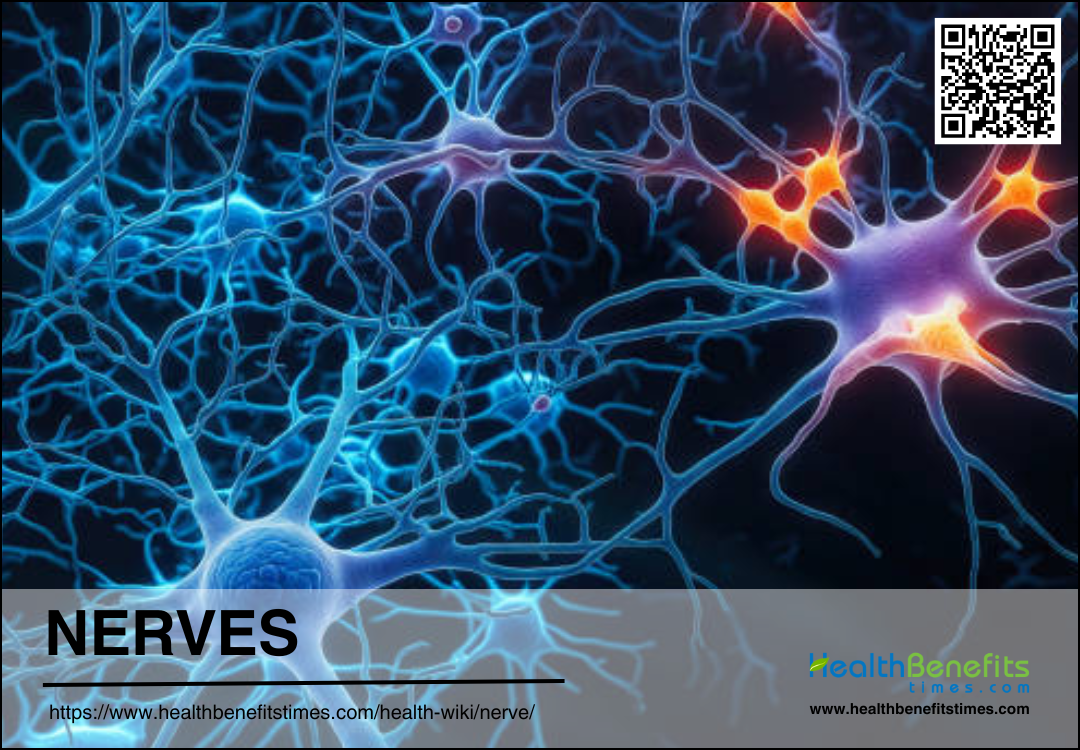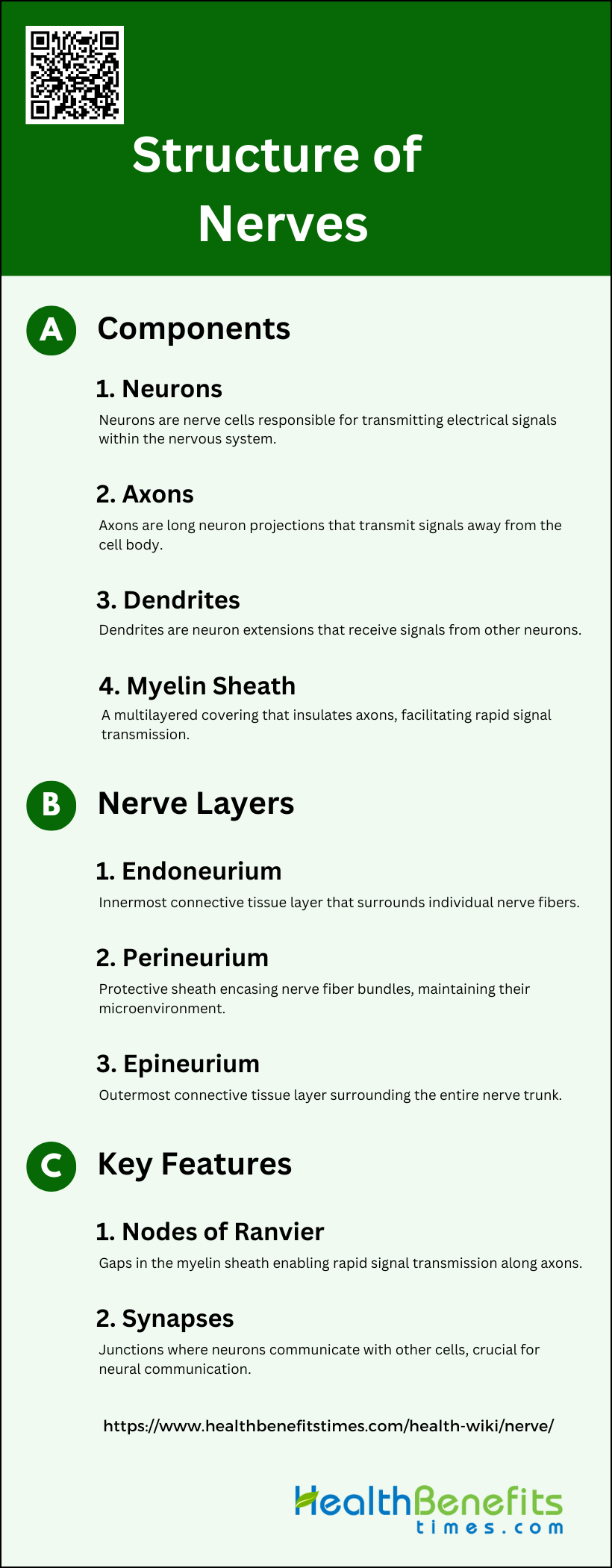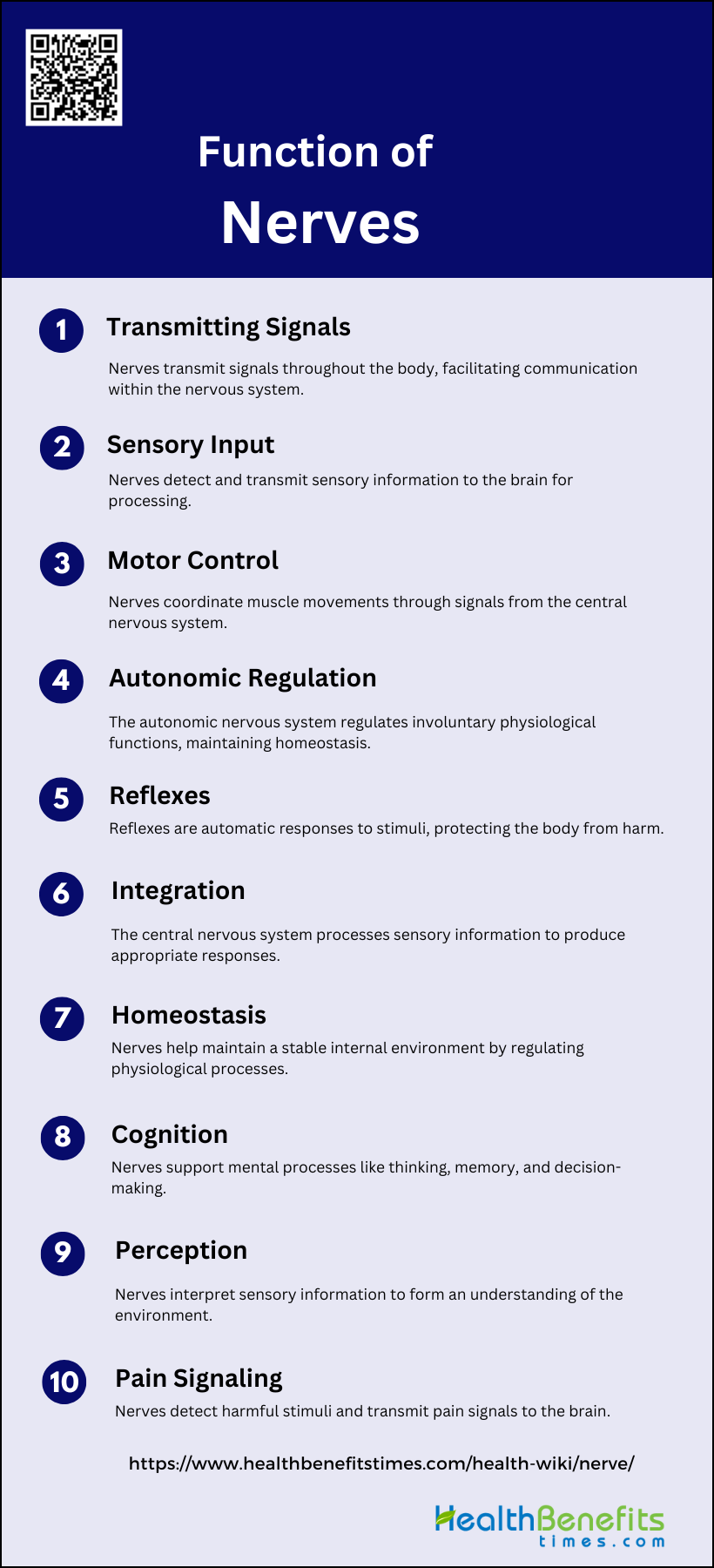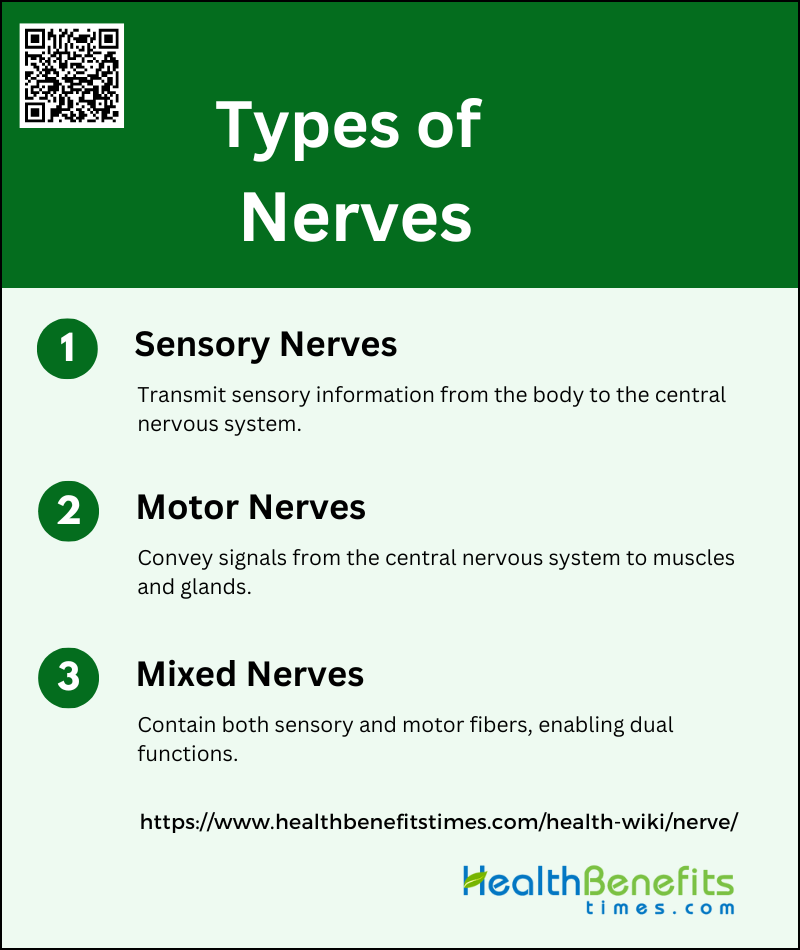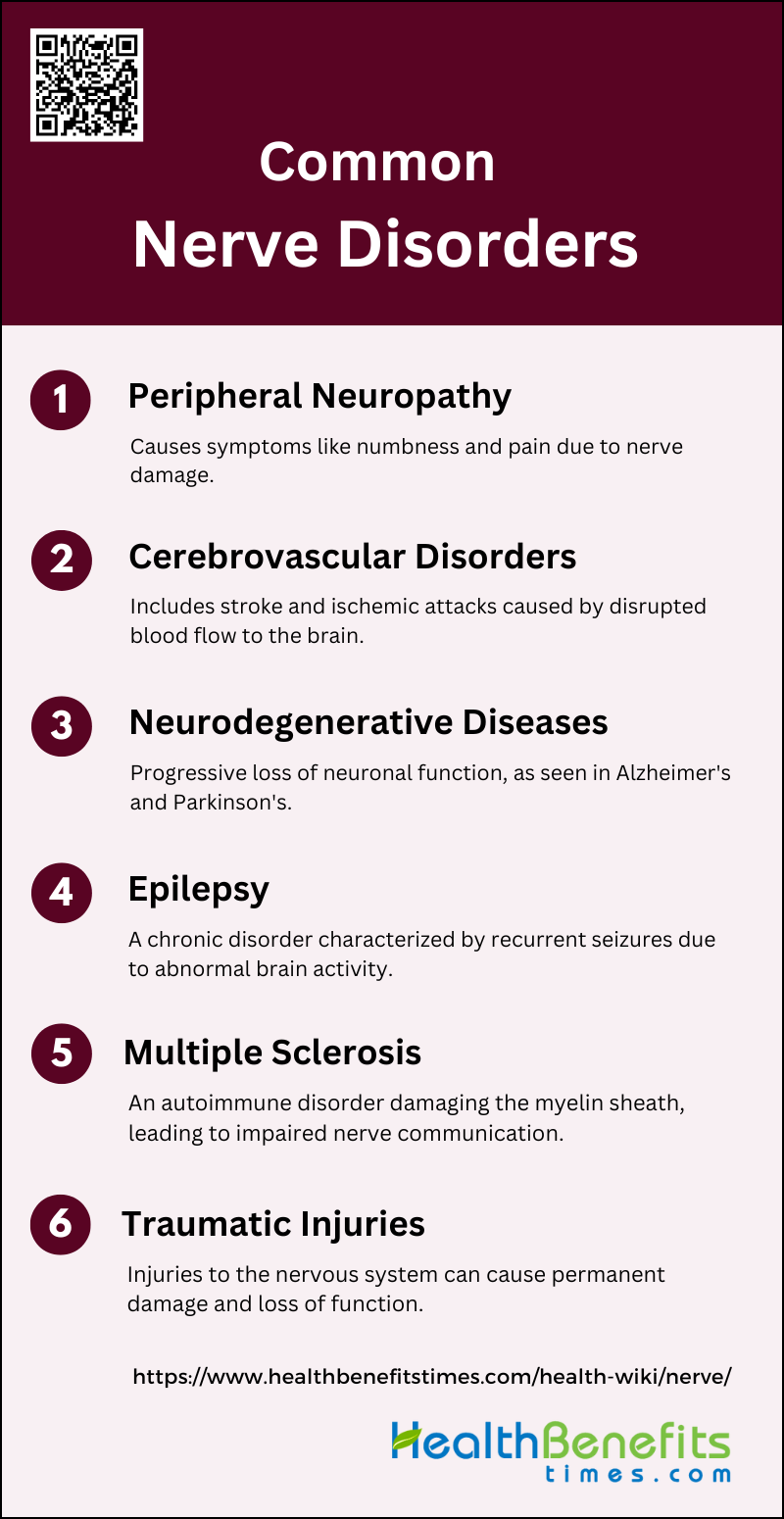A nerve is a complex structure that serves as a fundamental unit of the nervous system, responsible for transmitting signals between different parts of the body. Nerves are composed of bundles of nerve fibers, which include axons and dendrites, encased in connective tissue. These fibers can vary in diameter, influencing their conduction speed and excitability, with larger fibers typically conducting signals more rapidly and being more easily excited. Nerves can be classified into sensory, motor, and mixed types, each serving distinct functions such as transmitting sensory information, controlling muscle movements, or performing both roles. The intricate structure of nerves, including the presence of specialized regions like the axon hillock and nodes of Ranvier, facilitates efficient signal transmission and processing. The nervous system’s ability to adapt and reorganize in response to external stimuli, known as neuroplasticity, underscores the dynamic nature of nerve function.
Structure of Nerves
The structure of nerves is complex and vital for the nervous system’s functionality. Nerves consist of various components and layers that facilitate the efficient transmission of signals. Below is a detailed breakdown of these components and layers:
A. Components
1. Neurons
Neurons are the fundamental units of the nervous system responsible for receiving, processing, and transmitting electrical signals. They consist of a cell body (soma), dendrites, and an axon. The soma contains the nucleus and various organelles, while dendrites receive signals from other neurons. The axon transmits these signals to other neurons or effector cells. Neurons are highly specialized and exhibit diverse morphologies and functions, which are critical for the complex operations of the nervous system.
2. Axons
Axons are long, slender projections of neurons that conduct electrical impulses away from the neuron’s cell body. They are essential for transmitting information over long distances within the nervous system. Axons are supported by a cytoskeleton composed of neurotubules and tubulin, which facilitate the transport of organelles and proteins between the cell body and the axon terminal. Myelinated axons are wrapped in a myelin sheath, which enhances the speed and efficiency of electrical signal conduction.
3. Dendrites
Dendrites are branched extensions of the neuron that receive synaptic inputs from other neurons. They play a crucial role in integrating synaptic signals and determining the neuron’s response. Dendrites contain various organelles and cytoskeletal elements that support their function and structure. The morphology and distribution of dendrites can vary significantly among different types of neurons, reflecting their specialized roles in the nervous system.
4. Myelin Sheath
The myelin sheath is a multilayered covering formed by glial cells, such as oligodendrocytes in the central nervous system (CNS) and Schwann cells in the peripheral nervous system (PNS). It insulates axons, allowing for rapid and efficient transmission of electrical impulses through saltatory conduction. Myelin is essential for proper neural function and plasticity, and its dynamic regulation can influence neural circuit function and adaptation.
B. Nerve Layers
1. Endoneurium
The endoneurium is the innermost layer of connective tissue that surrounds individual nerve fibers within a nerve. It provides a supportive environment for the axons and their associated Schwann cells, facilitating the exchange of nutrients and waste products. The endoneurium also plays a role in maintaining the integrity and function of the nerve fibers, particularly during nerve regeneration and repair processes.
2. Perineurium
The perineurium is a protective sheath composed of concentric layers of cells that encase bundles of nerve fibers, known as fascicles. It acts as a barrier, regulating the microenvironment within the fascicles and protecting the nerve fibers from mechanical stress and chemical insults. The perineurium is crucial for maintaining the homeostasis and proper function of the nerve fibers it encloses.
3. Epineurium
The epineurium is the outermost layer of connective tissue that surrounds the entire nerve trunk, providing structural support and protection. It contains blood vessels that supply the nerve with essential nutrients and oxygen. The epineurium also helps to anchor the nerve within its surrounding tissues, ensuring stability and reducing the risk of injury.
C. Key Features
1. Nodes of Ranvier
Nodes of Ranvier are small gaps in the myelin sheath along myelinated axons where voltage-gated sodium channels are concentrated. These nodes are critical for the rapid propagation of action potentials through saltatory conduction, allowing electrical impulses to “jump” from one node to the next. The precise organization and maintenance of these nodes are essential for efficient nerve impulse transmission and overall neural function.
2. Synapses
Synapses are specialized junctions where neurons communicate with other neurons or effector cells. They consist of a presynaptic terminal, a synaptic cleft, and a postsynaptic membrane. Synapses can be electrical or chemical, with chemical synapses being the most common. At chemical synapses, neurotransmitters are released from the presynaptic terminal and bind to receptors on the postsynaptic membrane, initiating a response. Synapses are crucial for neural communication, plasticity, and the overall functioning of the nervous system.
Function of Nerves
Nerves serve multiple critical functions that are essential for the body’s overall operation. They transmit signals, gather sensory input, and control motor functions, among other roles. Below is a detailed breakdown of these functions:
1. Transmitting Signals
Nerves are essential for transmitting signals throughout the body, acting as the communication network of the nervous system. Sensory neurons convey information from sensory receptors to the central nervous system (CNS), while motor neurons transmit signals from the CNS to muscles and glands, facilitating movement and secretion. This bidirectional flow of information ensures that the body can respond appropriately to internal and external stimuli, maintaining overall function and coordination.
2. Sensory Input
Sensory input involves the detection and transmission of sensory information from the environment to the CNS. Sensory neurons, part of the peripheral nervous system, are responsible for this process. They detect changes in the environment, such as temperature, pressure, and chemical signals, and relay this information to the brain and spinal cord for processing. This sensory information is crucial for perception, reflexes, and initiating appropriate responses to stimuli.
3. Motor Control
Motor control is the process by which the nervous system coordinates muscle movements. Motor neurons transmit signals from the CNS to muscles, causing them to contract and produce movement. This process involves complex interactions between the brain, spinal cord, and peripheral nerves to ensure precise and coordinated actions. Damage to motor pathways, such as descending serotonergic fibers, can lead to motor dysfunctions like spasticity and impaired movement.
4. Autonomic Regulation
The autonomic nervous system (ANS) regulates involuntary physiological functions, including heart rate, digestion, and respiratory rate. It consists of the sympathetic and parasympathetic divisions, which work together to maintain homeostasis. The ANS integrates sensory information and modulates visceral functions through complex neural networks and reflexes. This regulation is crucial for adapting to changes in the internal and external environment.
5. Reflexes
Reflexes are automatic, rapid responses to stimuli that do not require conscious thought. They involve sensory neurons detecting a stimulus and transmitting the information to the spinal cord, where an immediate response is generated by motor neurons. Reflexes are essential for protecting the body from harm and maintaining posture and balance. For example, the inflammatory reflex helps regulate immune responses and prevent excessive inflammation.
6. Integration
Integration refers to the processing and interpretation of sensory information by the CNS to produce appropriate responses. This involves the coordination of sensory inputs, motor outputs, and higher brain functions to ensure coherent and adaptive behavior. The integration of autonomic and sensory information is vital for maintaining homeostasis and responding to environmental changes.
7. Homeostasis
Homeostasis is the maintenance of a stable internal environment, which is crucial for the body’s proper functioning. The ANS plays a significant role in regulating homeostasis by controlling various physiological processes, such as blood pressure, body temperature, and metabolic rate. It achieves this through a complex network of afferent and efferent signals that modulate organ functions and systemic metabolism.
8. Cognition
Cognition encompasses mental processes such as thinking, memory, and decision-making. The nervous system, particularly the brain, is responsible for these higher-order functions. Sensory input provides the necessary information for cognitive processes, while motor output allows for the execution of decisions and actions. Damage to neural pathways can impair cognitive functions, highlighting the importance of a well-functioning nervous system.
9. Perception
Perception is the interpretation of sensory information by the brain to form a coherent understanding of the environment. It involves the integration of signals from various sensory modalities, such as vision, hearing, and touch. Perception allows individuals to navigate and interact with their surroundings effectively. The nervous system’s ability to process and integrate sensory information is crucial for accurate perception.
10. Pain Signaling
Pain signaling involves the detection and transmission of noxious stimuli to the CNS, where it is perceived as pain. Sensory neurons, particularly polymodal nociceptors, play a key role in this process by responding to various harmful stimuli and conveying this information to the brain. The ANS also influences pain perception and modulation, with changes in autonomic function affecting pain sensitivity and chronic pain conditions.
Types of Nerves
Nerves can be classified into three main types based on their functions: sensory nerves, motor nerves, and mixed nerves. Each type plays a unique role in transmitting signals and coordinating various bodily functions. Below are types of Nerves:
1. Sensory Nerves
Sensory nerves are responsible for transmitting sensory information from various parts of the body to the central nervous system. They play a crucial role in perceiving external stimuli such as touch, temperature, pain, and pressure. For example, the vagus nerve, a major sensory nerve, monitors visceral functions in the cardio-pulmonary and gastrointestinal systems, and includes neuron types like C-low threshold mechanoreceptors and Aδ-nociceptors. These nerves are essential for conscious perception and maintaining homeostasis by relaying critical information about the body’s internal and external environments.
2. Motor Nerves
Motor nerves are responsible for conveying signals from the central nervous system to muscles and glands, thereby facilitating movement and various bodily functions. They enable voluntary and involuntary actions by transmitting motor commands that result in muscle contraction. For instance, the median nerve, which is a mixed nerve but predominantly motor, plays a significant role in controlling the muscles of the forearm and hand. Motor nerves are essential for executing coordinated movements and responding to external stimuli through physical actions.
3. Mixed Nerves
Mixed nerves contain both sensory and motor fibers, allowing them to perform dual functions: transmitting sensory information to the central nervous system and conveying motor commands to muscles. An example of a mixed nerve is the median nerve, which not only controls muscle movements but also transmits sensory information from the hand to the brain. These nerves are crucial for integrated bodily functions, enabling coordinated actions and sensory feedback, which are essential for complex tasks and overall bodily coordination.
Common Nerve Disorders
Nerve disorders can significantly impact the quality of life by affecting the nervous system’s ability to function properly. These disorders can arise from various causes, including genetic factors, injuries, and underlying health conditions. Below is a detailed overview of some common nerve disorders:
1. Peripheral Neuropathy
Peripheral neuropathy is a prevalent neurodegenerative condition affecting millions globally, characterized by symptoms such as numbness, tingling, and chronic pain. It can result from various causes, including diabetes, chemotherapy, and genetic factors. The condition often involves the degeneration of long axons, leading to motor and autonomic dysfunctions like muscle weakness and blood pressure irregularities. Recent research has identified the SARM1 enzyme as a key player in axon degeneration, offering new therapeutic targets for preventing and treating peripheral neuropathy.
2. Cerebrovascular Disorders
Cerebrovascular disorders, including stroke and transient ischemic attacks, are significant causes of morbidity and mortality worldwide. These conditions result from disruptions in blood flow to the brain, leading to neuronal damage. Stroke alone accounts for approximately 6.2 million deaths annually, with a higher prevalence in low- and middle-income countries. Effective management and prevention strategies are crucial, given the high incidence and severe impact of these disorders on patients’ quality of life.
3. Neurodegenerative Diseases
Neurodegenerative diseases, such as Alzheimer’s, Parkinson’s, and amyotrophic lateral sclerosis (ALS), involve the progressive loss of neuronal function and structure. These conditions are often linked to the accumulation of abnormal proteins and excitotoxicity due to overstimulation of excitatory amino acid receptors. The resulting neuronal damage leads to cognitive decline, motor dysfunction, and other severe symptoms. Understanding the underlying mechanisms, such as the role of glutamate in excitotoxicity, is essential for developing effective treatments.
4. Epilepsy
Epilepsy is a chronic neurological disorder characterized by recurrent seizures due to abnormal electrical activity in the brain. It affects over 50 million people worldwide and can significantly impair quality of life. The condition can result from various factors, including genetic predisposition, brain injuries, and infections. Effective management typically involves anticonvulsant medications, but ongoing research aims to better understand the disease’s mechanisms to develop more targeted therapies.
5. Multiple Sclerosis
Multiple sclerosis (MS) is an autoimmune disorder where the immune system attacks the myelin sheath of nerve fibers, leading to disrupted communication between the brain and the rest of the body. This results in symptoms such as muscle weakness, coordination issues, and cognitive impairments. The prevalence of MS varies globally, with significant morbidity associated with the disease. Current treatments focus on managing symptoms and slowing disease progression, but there is no cure.
6. Traumatic Injuries
Traumatic injuries to the nervous system, such as those resulting from accidents or sports, can lead to significant and often permanent damage. These injuries can affect both the central and peripheral nervous systems, resulting in loss of sensation, motor function, and in severe cases, paralysis. While the peripheral nervous system has some capacity for regeneration, central nervous system injuries pose greater challenges. Advances in biomaterials and cellular therapies offer promising avenues for enhancing nerve repair and functional recovery.
FAQs
1. How do nerves regenerate after injury?
Nerves have a limited capacity to regenerate after injury, particularly in the peripheral nervous system. This regeneration involves the growth of axons, guided by Schwann cells, towards their target tissues. However, nerve regeneration is often incomplete, and recovery can be slow and limited, particularly in the central nervous system where regenerative capacity is much lower.
2. What are the most common causes of nerve damage?
Nerve damage can be caused by a variety of factors, including physical injuries, diabetes, infections, autoimmune diseases, and exposure to toxins or certain medications. Chronic conditions like diabetes are among the most common causes of peripheral neuropathy, a type of nerve damage.
3. Can nerve damage be reversed?
The reversibility of nerve damage depends on the extent and cause of the damage. In some cases, early treatment can help restore nerve function, particularly if the damage is due to inflammation or compression. However, severe or long-standing damage, particularly in the central nervous system, may be irreversible.
4. How does aging affect nerve function?
Aging can lead to a gradual decline in nerve function, including slower reflexes, reduced sensation, and impaired coordination. This is due to the loss of neurons, reduced blood flow, and the accumulation of oxidative stress and other cellular damage over time.
5. What role do nerves play in pain perception?
Nerves, particularly nociceptors, are critical in detecting and transmitting pain signals to the brain. When a noxious stimulus is detected, these nerves send signals through the spinal cord to the brain, where they are interpreted as pain. Chronic pain can occur when these pain pathways become sensitized or overactive.
6. How do neurodegenerative diseases affect nerve structure and function?
Neurodegenerative diseases like Alzheimer’s, Parkinson’s, and ALS lead to the progressive loss of neurons and their connections, disrupting the normal structure and function of nerves. This results in symptoms such as cognitive decline, motor dysfunction, and other neurological impairments.
7. What is the difference between nerve pain and muscle pain?
Nerve pain, often described as sharp, burning, or tingling, results from damage or irritation to nerves and is typically felt along the path of the affected nerve. Muscle pain, on the other hand, is usually a dull, aching sensation that occurs due to muscle strain, overuse, or injury.
8. Can lifestyle changes improve nerve health?
Yes, lifestyle changes such as maintaining a healthy diet, regular exercise, managing blood sugar levels (especially for diabetics), avoiding excessive alcohol consumption, and not smoking can significantly improve nerve health and reduce the risk of nerve damage.
9. What are the latest advancements in nerve repair treatments?
Recent advancements in nerve repair include the development of biomaterials for nerve grafts, stem cell therapy, and neurotrophic factors that promote nerve growth and regeneration. Research is also exploring gene therapy and electrical stimulation techniques to enhance nerve repair.
10. How does the nervous system differentiate between different types of sensory stimuli?
The nervous system differentiates between various sensory stimuli through specialized sensory receptors. Each type of receptor is sensitive to a specific kind of stimulus (e.g., temperature, pressure, pain), and the information is processed and interpreted by different regions of the brain, allowing us to perceive distinct sensations.


